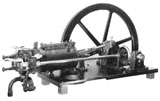Car work for quantum mechanics

The last leap forward: Otto’s first four stroke engine of 1876. <br>Courtesy of Deutz Canada Inc. <br>
A quantum afterburner extracts laser light from vehicle exhaust.
The hot gases belching out of your car’s exhaust are not just useless waste. They are a laser waiting to happen, says physicist Marlan Scully1.
All you need to harness this potential, suggests Scully, of Texas A&M University in College Station, is a quantum afterburner. This hypothetical modification would use quantum mechanics to boost the engine’s efficiency by clawing back waste heat and turning it into useful energy – laser light.
Scully’s quantum soup-up would involve adding two new parts to an exhaust pipe: a laser and a maser (a kind of laser that emits microwaves rather than visible light). Both would produce radiation as soon as the number of high-energy molecules in the hot gas became abnormally large.
Normally, the higher the energy of excited molecules, the fewer of them there are. But in lasers, there is a population inversion – the gas becomes rich in excited molecules. Excited molecules then lose their energy by emitting it as light.
The quantum afterburner would rely on exhaust molecules being in three different states, like three rungs on an energy ladder. The maser would wring out energy from excited molecules on the second rung, sending them to the bottom rung. This depletion of the second rung would create a population inversion between it and the first rung that would produce laser emission.
In effect, says Scully, the maser would drain some heat from the exhaust gas so that the remainder could be extracted as useful laser emission. In a normal engine, all the heat in the exhaust is disregarded as useless.
Scully and others are now trying to build a real quantum engine, to probe the feasibility of his idea.
Work it
Engine efficiency is an old problem. The scientists who investigated it during the Industrial Revolution created the discipline called thermodynamics, which describes how heat flows from place to place.
In the early nineteenth century, the French engineer Nicholas Léonard Sadi Carnot calculated the maximum work available from an engine in which heating a gas through a cycle of expansion and contraction drives the motion of a piston.
Scully has taken a fresh look at the efficiency of such a cyclical process, not in a Carnot engine, but in an Otto engine. Devised in 1876 by Nikolaus Otto, this system forms the basis of today’s four-stroke internal-combustion engine.
In the Otto engine, a moving piston sucks fuel into a cylinder and then compresses it. The fuel is ignited and expands, pushing the piston outwards. The piston then expels the spent exhaust gases.
References
- Scully, M.O.Quantum afterburner: improving the efficiency of an ideal heat engine. Physical Review Letters, 88, 050602, (2002).
Media Contact
All latest news from the category: Power and Electrical Engineering
This topic covers issues related to energy generation, conversion, transportation and consumption and how the industry is addressing the challenge of energy efficiency in general.
innovations-report provides in-depth and informative reports and articles on subjects ranging from wind energy, fuel cell technology, solar energy, geothermal energy, petroleum, gas, nuclear engineering, alternative energy and energy efficiency to fusion, hydrogen and superconductor technologies.
Newest articles

First-of-its-kind study uses remote sensing to monitor plastic debris in rivers and lakes
Remote sensing creates a cost-effective solution to monitoring plastic pollution. A first-of-its-kind study from researchers at the University of Minnesota Twin Cities shows how remote sensing can help monitor and…

Laser-based artificial neuron mimics nerve cell functions at lightning speed
With a processing speed a billion times faster than nature, chip-based laser neuron could help advance AI tasks such as pattern recognition and sequence prediction. Researchers have developed a laser-based…

Optimising the processing of plastic waste
Just one look in the yellow bin reveals a colourful jumble of different types of plastic. However, the purer and more uniform plastic waste is, the easier it is to…



